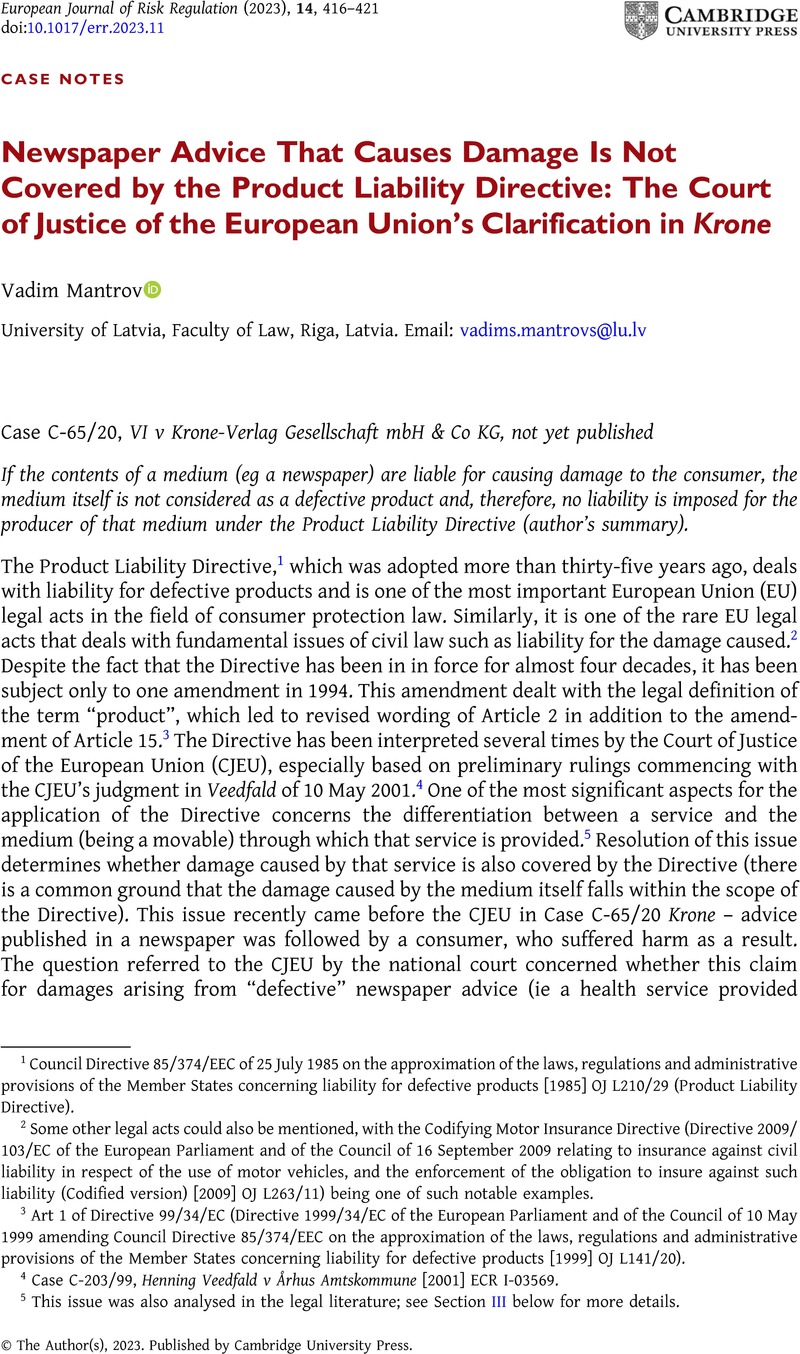No CrossRef data available.
Published online by Cambridge University Press: 30 March 2023

1 Council Directive 85/374/EEC of 25 July 1985 on the approximation of the laws, regulations and administrative provisions of the Member States concerning liability for defective products [1985] OJ L210/29 (Product Liability Directive).
2 Some other legal acts could also be mentioned, with the Codifying Motor Insurance Directive (Directive 2009/103/EC of the European Parliament and of the Council of 16 September 2009 relating to insurance against civil liability in respect of the use of motor vehicles, and the enforcement of the obligation to insure against such liability (Codified version) [2009] OJ L263/11) being one of such notable examples.
3 Art 1 of Directive 99/34/EC (Directive 1999/34/EC of the European Parliament and of the Council of 10 May 1999 amending Council Directive 85/374/EEC on the approximation of the laws, regulations and administrative provisions of the Member States concerning liability for defective products [1999] OJ L141/20).
4 Case C-203/99, Henning Veedfald v Århus Amtskommune [2001] ECR I-03569.
5 This issue was also analysed in the legal literature; see Section III below for more details.
6 Facts are summarised in paras 13–23 of the Judgment (Case C-65/20, VI v Krone-Verlag Gesellschaft mbH & Co KG, not yet published) and paras 1, 9–21 of the Opinion (Case C-65/20, VI v Krone-Verlag Gesellschaft mbH & Co KG, not yet published, Opinion of AG Hogan).
7 Please note that this Article was rephrased in 1999; therefore, the Court interpreted the amended Article based on the ratione temporis consideration.
8 Paras 26–29 of the Judgment.
9 ibid, paras 30–31.
10 Joined Cases C-503/13 and C-504/13, Boston Scientific Medizintechnik GmbH v AOK Sachsen-Anhalt – Die Gesundheitskasse and Betriebskrankenkasse RWE Courts Reports – General (Boston Scientific Medizintechnik).
11 ibid, paras 33–36.
12 Case C-495/10, Centre hospitalier universitaire de Besançon v Thomas Dutrueux and Caisse primaire d’assurance maladie du Jura [2011] ECR 00000 (Dutrueux).
13 Case C-183/00 María Victoria González Sánchez v Medicina Asturiana SA [2002] ECR I-03901 (González Sánchez).
14 ibid, paras 37–41.
15 ibid, para 42.
16 Opinion, para 1.
17 Veedfald, para 2.
18 See, in particular, paras 29–34 of the judgment in González Sánchez in conjuncture with para 10 of that judgment.
19 Case C-402/03, Skov Æg v Bilka Lavprisvarehus A/S and Bilka Lavprisvarehus A/S v Jette Mikkelsen and Michael Due Nielsen [2006] ECR I-00199 (Skov).
20 Case C-127/04, Declan O’Byrne v Sanofi Pasteur MSD Ltd and Sanofi Pasteur SA [2006] I-01313; Case C-358/08, Aventis Pasteur SA v OB [2009] ECR I-11305.
21 Case C-285/08, Moteurs Leroy Somer v Dalkia France and Ace Europe [2009] ECR I-04733.
22 Case C-495/10, Centre hospitalier universitaire de Besançon v Thomas Dutrueux [2011] ECR I-14174.
23 Case C-310/13, Novo Nordisk Pharma GmbH v S Court Reports – General.
24 Case C-621/15, N. W and Others v Sanofi Pasteur MSD SNC and Others Court Reports – General.
25 See especially paras 50 and 53.
26 See, for instance, C Twigg-Flesner, “The Tale of the Grating Horseradish: Case Note on VI v KRONE-Verlag (Case C-65/20 VI)” (2021) 6 Journal of European Consumer and Market Law 262; Piotr Machnikowski, “Product Liability for Information Products?: The CJEU Judgment in VI/KRONE-Verlag Gesellschaft mbH & Co KG, 10 June 2021 [C-65/20]” (2022) 1 European Review of Private Law 191.
27 See Machnikowski, supra, note 26, 196–99.
28 See, for instance, G Howells and S Weatherill, Consumer Protection Law, 2nd edition (Farnham, Ashgate 2005) p 236; H-W Micklitz, “Liability for Defective Products and Services” in N Reich, H-W Micklitz, P Rott and K Tonner (eds), European Consumer Law (Cambridge, Intersentia 2014) pp 246–53 (whilst not mentioned explicitly, this conclusion is based on the overall discussion in this chapter); M Nietsch, “§ 23 Produkthaftung” in M Tamm, K Tonner and T Brönneke (eds), Verbraucherrecht, 3rd edition (Baden-Baden, Nomos 2019) p 1302.
29 Howells and Weatherill, supra, note 28, 236.
30 Judgment, para 22.
31 Opinion, para 25.
32 But there are also other publications with a similar view; for instance, one such publications was analysed in an earlier case note concerning the discussed case (see Twigg-Flesner, supra, note 26, 264–65).
33 G Spindler, “Verschuldensunabhängige Produkthaftung im Internet” (1998) 3 Multimedia und Recht 119.
34 ibid, 122–23.
35 Commission, “Proposal for a Directive of the European Parliament and of the Council on liability for defective products” COM/2022/495 final.
36 Preamble, Recital 15.
37 ibid. See also the legal definition of the term “product” in Art 4(1) in conjuncture with Art 10(2) of the proposed directive.